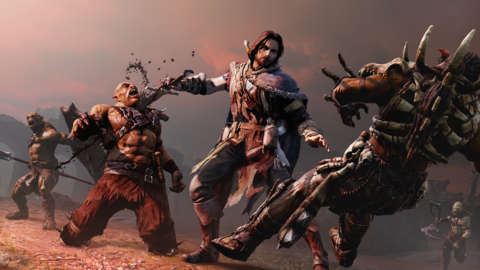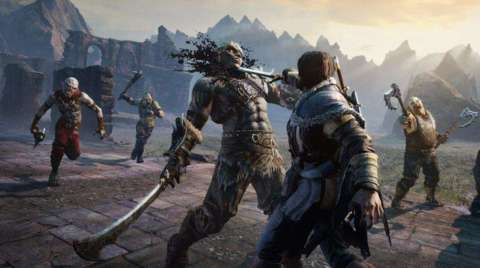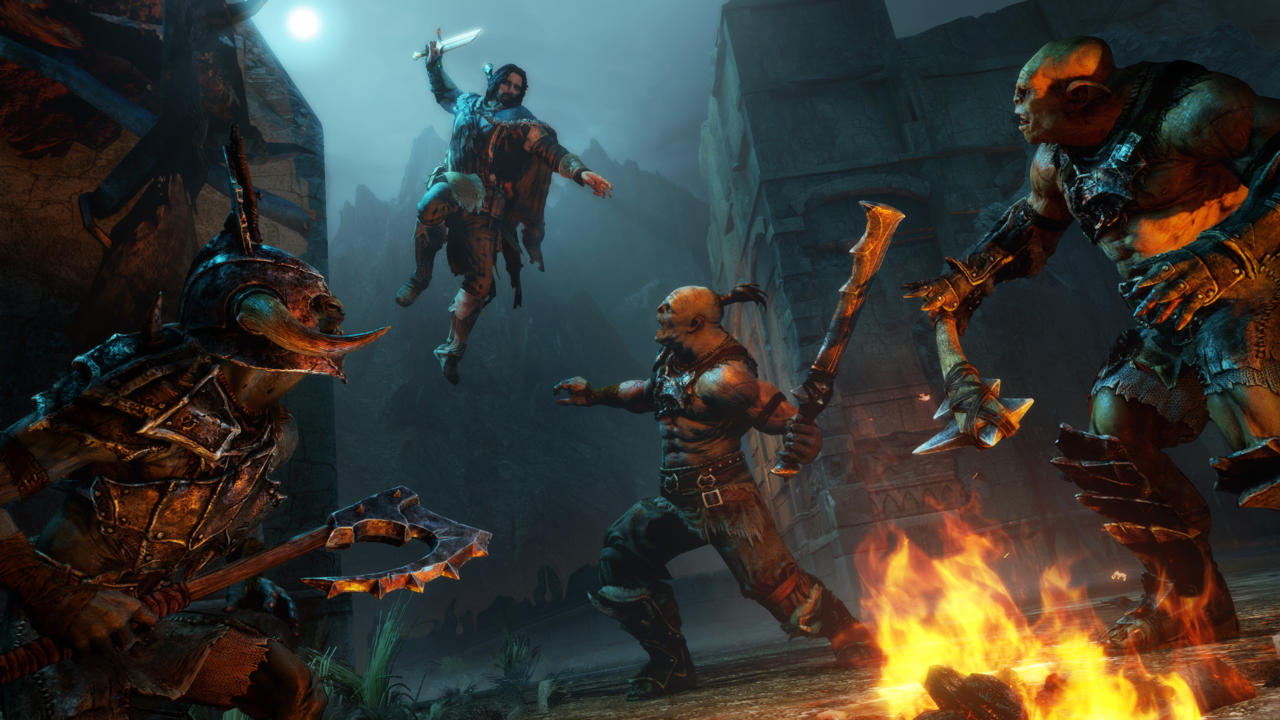Shadow of Mordor's Nemesis System Was Inspired by Batman and Sports Games
Monolith was inspired by the Arkham games, but the system was developed specially for Mordor.
Middle-earth: Shadow of Mordor's Nemesis system was inspired by elements of the Batman franchise, but the core features of the framework were built on lessons learned from sports games and pen-and-paper role-playing games.
Design director Michael de Plater said that while the much-praised system, one of the game's most standout features, seems like it would be at home in an Arkham game, it was dreamed up entirely from scratch after the studio decided on making a Lord of the Rings game. The idea to make a game set in Middle-earth came first, followed by the desire to create a unique enemy system with powerful combat to match.
Three months into Shadow of Mordor's three-year development cycle, Monolith solidified the framework of what would become the system, with every department contributing something. Not only did programmers start building the complex code, but artists and character designers had to begin fleshing out dozens of different visual cues that could be ascribed to the procedurally generated Orcs that would populate it.
Sclash - Console Release Date Trailer Kingdom Come: Deliverance 2 - Official Cinematic Announcement Trailer Stellar Blade - BIBI ‘Eve’ Official Music Video Trailer | PS5 Apex Legends: Urban Assault Collection Event Trailer Total War: WARHAMMER III - Elspeth von Draken Gameplay Showcase Genshin Impact - "Arlecchino: Sleep in Peace" | Official Character Teaser Microsoft Xbox Press Conference Gamescom 2017 We Have The Time Of Our Lives With Night Trap Remastered Trial Of The Sword On MASTER MODE - Zelda Try-Force We Return To The 90's With Sonic Mania How Many Headshot Punches Can We Get on PUBG Mondays We Try To Put Paperboy 64 Out of Business - Game Dump
Please enter your date of birth to view this video
By clicking 'enter', you agree to GameSpot's
Terms of Use and Privacy Policy
"We had the notion of enemies remembering and reacting and responding and growing, so there was that huge element in the writing component," de Plater explained. "But we also knew we wanted the presentation to be really strong, and we wanted [the Orcs] to feel like real villains, like Tarantino movie villains that we could zoom in on and bring to life. So we knew character art would play a huge part, because we wanted them to feel that, as villains, we could make them as memorable as they could be, whether it's in visuals or mannerisms or maybe a trait."
What Shadow of Mordor did borrow from Batman was its emphasis on tortured and physically maimed villains. Mordor is a torrid area full of strife and danger, with all life living within its borders constantly at each other's throats. Caragors and Ghuls battle each other, Graugs hunt down and dine on Orcs, and every beast is always against every other beast. De Plater wanted Shadow of Mordor's living world to preserve this feeling--a feeling also present in Batman's Gotham, in which villains form tentative alliances but are always vying to be evil's top dog.
"We wanted to make an action game with a hero in the center, but how do you get over the idea of the one-man army, which is inherent to any action game, and still make it plausible within Middle-earth?" de Plater said. "The thing that was a big inspiration, and it's in Batman and Lord of the Rings as well as a lot of other places... Batman has a lot of iconic scarred villains. They have been scarred and their stories are tied into their relationship with the hero. We wanted to make a villain simulator, and make scarring and memory and that relationship into a personal nemesis."

The Nemesis system even predated the addition of Celebrimbor and Talion's access to his Wraith powers. At that time, the system had individual "under the hood knobs" that went deeper into each Orc's traits, including ones for morale, how well trained they were and any factional tensions between them. De Plater described the early Nemesis system as "overcomplicated," with a lot more emphasis on Orcs personal relationships. This was eventually stripped down and simplified to the version players are familiar with now.
"The idea of memory and revenge and enemies with scars, that combination of fear and in-fighting in a living world was what we wanted, " he said. "So we brought it back to being a villain simulator and less a meta-strategy game."
After deciding how it would be used, populating the Nemesis system was the next big challenge. De Plater explained that the team drew from pen and paper role-playing games as they decided how to outfit each Orc's abilities, fears, and strengths in order to make them memorable.
"If you're a dungeon master and you want people to remember particular villains, you're always going to give them a trait or mannerism or a quirk, something people can catch onto and remember," de Plater said. "One of our goals was to ensure that the combat didn't become repetitive, as the core activity is the combat. Then it was looking for traits that would make you play against each one of these guys differently. We knew we weren't going to be like Arkham where it was, here's a combat area, and here's a predator area. We weren't going to break that up in an open world, so we had to make the enemies be the thing that signaled you needed to approach with range or stealth or combat."

While most Orcs within the Nemesis system will follow fairly the same formula in terms of behavior and dialogue, there are a few carefully placed Orcs with specific traits that only appear once. The dialogue and more wild personalities of these Orcs--a captain that constantly talks to his axe or a warchief wearing his twin's severed head on his shoulder--were penned by Dan Abnett, a comic book writer and novelist who has worked on Guardians of the Galaxy and numerous Warhammer 40K novels. Abnett wrote systemic dialogue for these quirkier Orcs. Monolith nested them within the system into "crafted pockets" that would take players by surprise; after hours of coming up against your standard fare Orcs, having one really weird captain or bodyguard would add a bit more drama to the emergent narrative. This was the same idea behind the Orc Ratbag, who guides players through several story missions towards the beginning of the game and helps demonstrate how the Orc military hierarchy works.
Another unlikely inspiration for the Nemesis system was sports games.
"In sports games, you very much create your own narrative through a season," de Plater explained. "You play match by match. And in sports games, if you lose, it doesn't reset the story. You can play that again, and failure doesn't mean you replay, it just adds more drama and tension to the next match. There are more challenges to overcome, your rivals become more powerful, you've created mini vendettas and rivalries. And there are lots of ideas surrounding individual players, they have their own attributes and their own histories."

Orcs calling out to Talion prior to joining a fight was also partially inspired by the commentary in sports games, where commentators recap the history between the two teams and narratively set the stage for the next game.
"Those ideas of having every single NPC being an individual with their own name and identity and stats and growth, of having you create you own narrative across the course of the game and have the game remember what you've done and speak to it through the dialogue--that was very inspired by sports."
Middle-earth: Shadow of Mordor is currently available on PlayStation 3, PlayStation 4, Xbox 360, Xbox One, and Windows PC. The game has been nominated for Best Game and Best Action/Adventure Game for the 2014 Game Awards, while developer Monolith is nominated for Developer of the Year and voice actor Troy Baker is nominated for his work as protagonist Talion.
Got a news tip or want to contact us directly? Email news@gamespot.com
Join the conversation